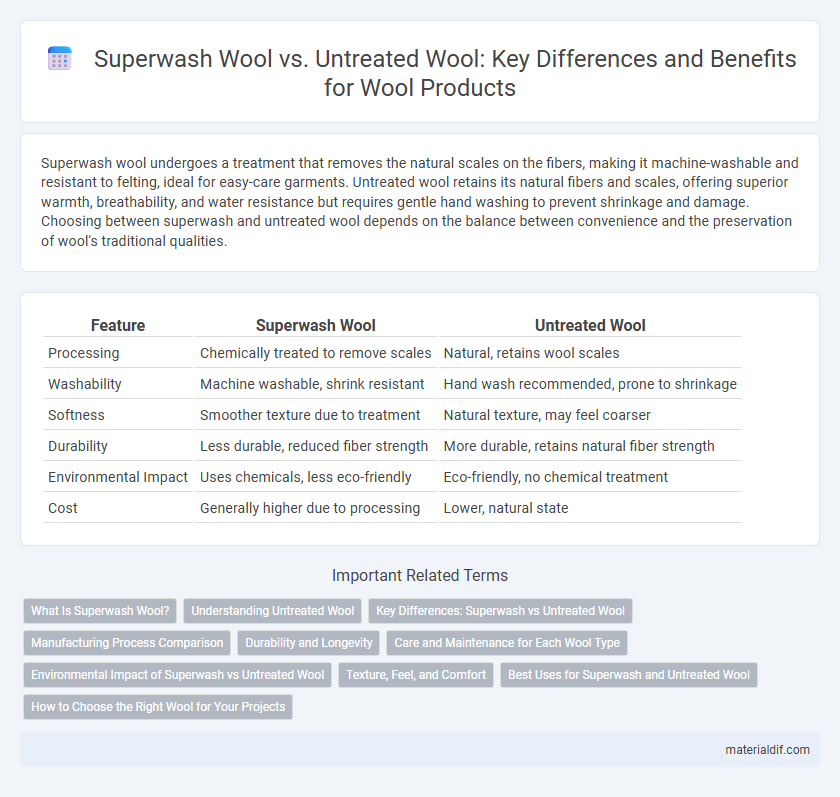Superwash wool undergoes a treatment that removes the natural scales on the fibers, making it machine-washable and resistant to felting, ideal for easy-care garments. Untreated wool retains its natural fibers and scales, offering superior warmth, breathability, and water resistance but requires gentle hand washing to prevent shrinkage and damage. Choosing between superwash and untreated wool depends on the balance between convenience and the preservation of wool's traditional qualities.
Table of Comparison
| Feature | Superwash Wool | Untreated Wool |
|---|---|---|
| Processing | Chemically treated to remove scales | Natural, retains wool scales |
| Washability | Machine washable, shrink resistant | Hand wash recommended, prone to shrinkage |
| Softness | Smoother texture due to treatment | Natural texture, may feel coarser |
| Durability | Less durable, reduced fiber strength | More durable, retains natural fiber strength |
| Environmental Impact | Uses chemicals, less eco-friendly | Eco-friendly, no chemical treatment |
| Cost | Generally higher due to processing | Lower, natural state |
What Is Superwash Wool?
Superwash wool is treated with a chemical or mechanical process that prevents the fibers from felting and shrinking during washing, making it machine-washable. Unlike untreated wool, which requires delicate hand washing to maintain its softness and shape, superwash wool fibers are coated or stripped of their scales to enhance durability and ease of care. This treatment preserves the natural warmth and breathability of wool while offering greater convenience for everyday use.
Understanding Untreated Wool
Untreated wool retains its natural lanolin, which provides moisture-wicking properties and enhanced insulation compared to Superwash wool that undergoes chemical treatment to remove these oils. This natural state promotes breathability and durability but may require more careful washing to avoid shrinkage or felting. Many consumers prefer untreated wool for its eco-friendly production process and superior thermal regulation in outdoor and cold-weather apparel.
Key Differences: Superwash vs Untreated Wool
Superwash wool undergoes a chemical treatment that removes the scales on the fiber surface, preventing felting and enabling machine washing, while untreated wool retains its natural scales, requiring gentle hand washing to avoid shrinkage. The durability of superwash wool is enhanced for everyday use, offering easy care and resilience, whereas untreated wool provides superior breathability and moisture-wicking properties due to its untouched fiber structure. These differences influence the choice between superwash and untreated wool based on care preferences, tactile qualities, and performance in various textile applications.
Manufacturing Process Comparison
Superwash wool undergoes a specialized treatment involving chlorination or coating with a polymer resin to remove or smooth the wool's scales, enabling machine washability without felting. Untreated wool retains its natural scales and requires gentle hand washing to prevent shrinkage or damage. The manufacturing process for Superwash wool is more complex and environmentally intensive due to chemical treatments, whereas untreated wool involves minimal processing, preserving its natural state.
Durability and Longevity
Superwash wool undergoes a chemical treatment that removes the natural scales on fibers, significantly enhancing its durability and resistance to felting compared to untreated wool. Untreated wool retains its natural structure, offering superior breathability and warmth but is more susceptible to shrinkage and wear over time. Choosing superwash wool ensures longer garment longevity with easier maintenance, especially for frequently worn or machine-washed items.
Care and Maintenance for Each Wool Type
Superwash wool undergoes a special chemical treatment that removes or coats the scales, making it machine washable and less prone to felting, thus simplifying care with gentle cycles and mild detergents. Untreated wool retains its natural scales, requiring hand washing in cold water and flat drying to prevent shrinkage and maintain fiber integrity. Proper storage in a cool, dry place and protection from moths benefits both types, but untreated wool demands more delicate handling to preserve its texture and shape.
Environmental Impact of Superwash vs Untreated Wool
Superwash wool undergoes chemical treatments like chlorination and polymer coatings to prevent felting, resulting in higher environmental impact due to toxic wastewater and non-biodegradable residues. Untreated wool retains natural biodegradability and requires fewer chemical inputs, lowering pollution and energy consumption during processing. Choosing untreated wool supports sustainable fiber use by minimizing harmful chemical discharge and promoting eco-friendly disposal.
Texture, Feel, and Comfort
Superwash wool undergoes a chemical treatment that removes the wool's natural scales, resulting in a smoother texture and softer feel compared to untreated wool. Untreated wool retains its natural lanolin and scales, which offer a more textured surface but can feel coarser against the skin. While superwash wool provides enhanced comfort and itch-free wear ideal for sensitive skin, untreated wool excels in breathability and moisture-wicking properties, catering to those seeking natural fiber performance.
Best Uses for Superwash and Untreated Wool
Superwash wool is ideal for everyday garments like socks, sweaters, and baby clothes due to its machine-washable properties and durability, making it a practical choice for items needing frequent cleaning. Untreated wool, retaining natural lanolin, excels in outdoor and winter wear because of its superior insulation, moisture-wicking, and breathability, providing warmth and comfort in harsh conditions. Both types cater to different needs: superwash for convenience and easy care, untreated for natural performance and longevity in rugged use.
How to Choose the Right Wool for Your Projects
Superwash wool undergoes a chemical treatment that allows it to be machine-washed without felting, making it ideal for beginners and projects requiring easy care, such as socks and baby garments. Untreated wool retains its natural lanolin and fiber structure, offering superior breathability, warmth, and durability, preferred for high-quality outerwear and traditional knitting techniques. Assess your project's care requirements, desired texture, and durability to determine whether the convenience of superwash or the natural properties of untreated wool best fits your needs.
Superwash Wool vs Untreated Wool Infographic

 materialdif.com
materialdif.com